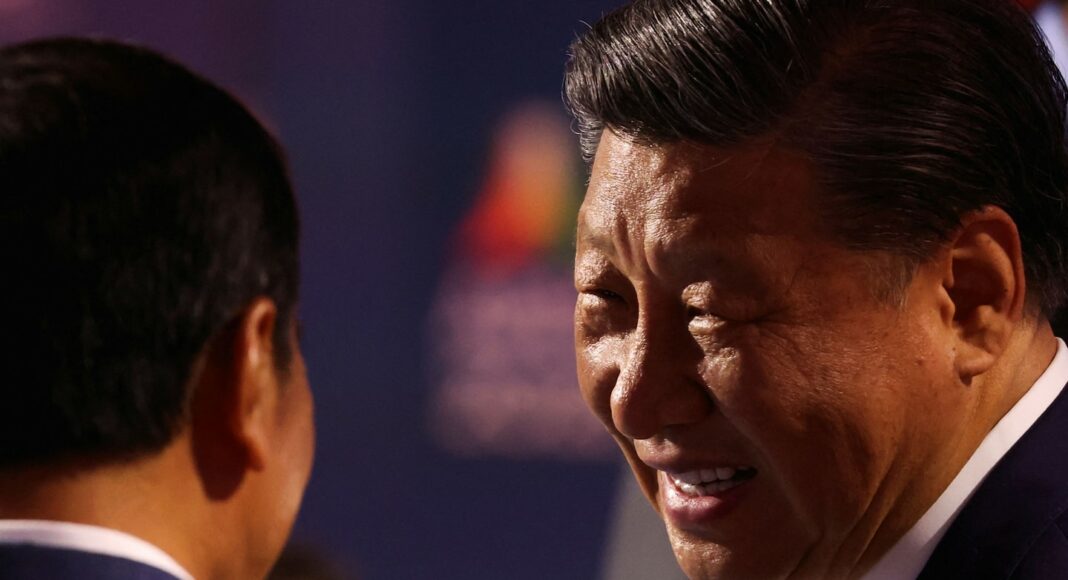Ειδήσεις Ελλάδα
Comment on this storyCommentAdd to your saved storiesSave
China’s leader Xi Jinping seemed to have a lot to smile about on Wednesday night.
He had more than four hours of dialogue with President Biden, who described the meeting as among the “most productive and constructive” sit-downs the two had ever had. Earlier, the American president had even complimented his car, a Chinese-made luxury sedan.
And, eliciting the widest smile of all: California Gov. Gavin Newsom had just given him a custom Golden State Warriors Jersey, with the word “warrior” written in Chinese characters on the front and “Xi” emblazoned across the back.
But despite the warm words, the two superpowers remain deeply distrustful of one another. Indeed, Xi said on Wednesday that the United States should not “scheme to suppress and contain China,” according to the Ministry of Foreign Affairs. Many issues that have been major sticking points in the relationship between the world’s two largest economies remain unresolved.
The United States remains so wary of China’s technological aims that it maintains export controls on key technologies like semiconductors, which Beijing has decried as a bid to contain China’s growth.
Whiplash in China as state media does U-turn on U.S.
Beijing resolutely adheres to its claims on Taiwan — which it has never ruled but considers part of its territory — with Xi repeating calls for Washington to stop selling arms to the island democracy.
And China continues to assertively push its claims in the South China Sea, putting up a floating barrier across waters claimed by the Philippines.
But analysts say that given the dire state of the relationship, any communication is a step in the right direction.
“It’s almost as if the biggest achievement of the meeting is the meeting itself,” said Yun Sun, director of the China program at the Stimson Center in Washington.
China’s Xi, in need of a win, appears ready to engage with Biden
“There is a sense from the Chinese side that they are tired from this intense confrontational posture toward the U.S. and feeling like it’s not getting China anywhere,” she said.
The two sides did agree to work together in some areas. They agreed to set up a working group on artificial intelligence, restart formal climate change talks and work together to cut off the global flow of fentanyl, which contains many chemicals produced in China.
And they agreed to reestablish communication between their militaries, which Beijing had severed after House Speaker Nancy Pelosi visited Taiwan last year. Despite dangerous near misses in the waters and airspace around China, Beijing had rejected Washington’s previous requests to resume talks.
But this doesn’t alter the reason for the near misses: China is growing increasingly aggressive in its activity near Taiwan and in regional waters. Beijing sent 336 aircraft to the edges of Taiwanese airspace in September alone.
How Chinese aggression is increasing the risk of war in the Taiwan Strait
“There is a lot going on across the Taiwan Strait and in the broader region which does require the two militaries to have regular communication channels,” said Jingdong Yuan, director of the China and Asia Security Program at the Stockholm International Peace Research Institute. “In that regard, this is quite significant. But really, it’s just a return to the status from before Pelosi’s visit.”
And while Chinese state media has lauded the visit as getting the relationship back on track and positioning China and the United States as superpowers on equal footing, analysts say Xi’s main objective in California was economic.
Foreign businesses in China have been spooked by raids on business intelligence firms like Bain and Mintz, a growing use of exit bans and an expanded anti-spy law that could call ordinary business activities into question.
U.S. engages in frank talks amid warnings China has become ‘uninvestible’
Against this backdrop, foreign direct investment in China has plummeted. In the third quarter of this year, more investment flowed out of China than came in, for the first time since such data has been recorded, according to China’s State Administration of Foreign Exchange.
What Xi got out of his visit to California was the chance to engage with U.S. business leaders — particularly tech entrepreneurs — directly, said Nadège Rolland, a scholar at the National Bureau of Asian Research who was previously an adviser to the French Ministry of Defense.
“The real target was to engage with the business community, the positive tone was also meant for them to know that China is still open for business,” said Rolland. “While the discussions within the U.S. government are taking the road of de-risking and diversification, Xi has addressed the business community directly saying we need to engage.”
The dinner was an opportunity for Xi to address the leaders of U.S. tech companies like Apple and Microsoft, who rely on China for core parts of their business, without the Biden administration as an intermediary, said Rolland.
“Beijing is starting to feel the pain [from sanctions] and this is going to create troubles for their ambitions to become a technologically strong country,” she said.
Biden speaks after meeting with Xi: 6 takeaways
Although key issues remain, Beijing clearly hopes that the visit will demonstrate willingness to prevent the relationship from entering a downward spiral, said Xin Qiang, deputy director of the Center for American Studies at Fudan University in Shanghai. “We are not talking about a sudden turnaround, but a détente and exchange of goodwill that may lead to pragmatic cooperation in some fields. And that is already the best that can happen.”
Lyric Li contributed to this report.



